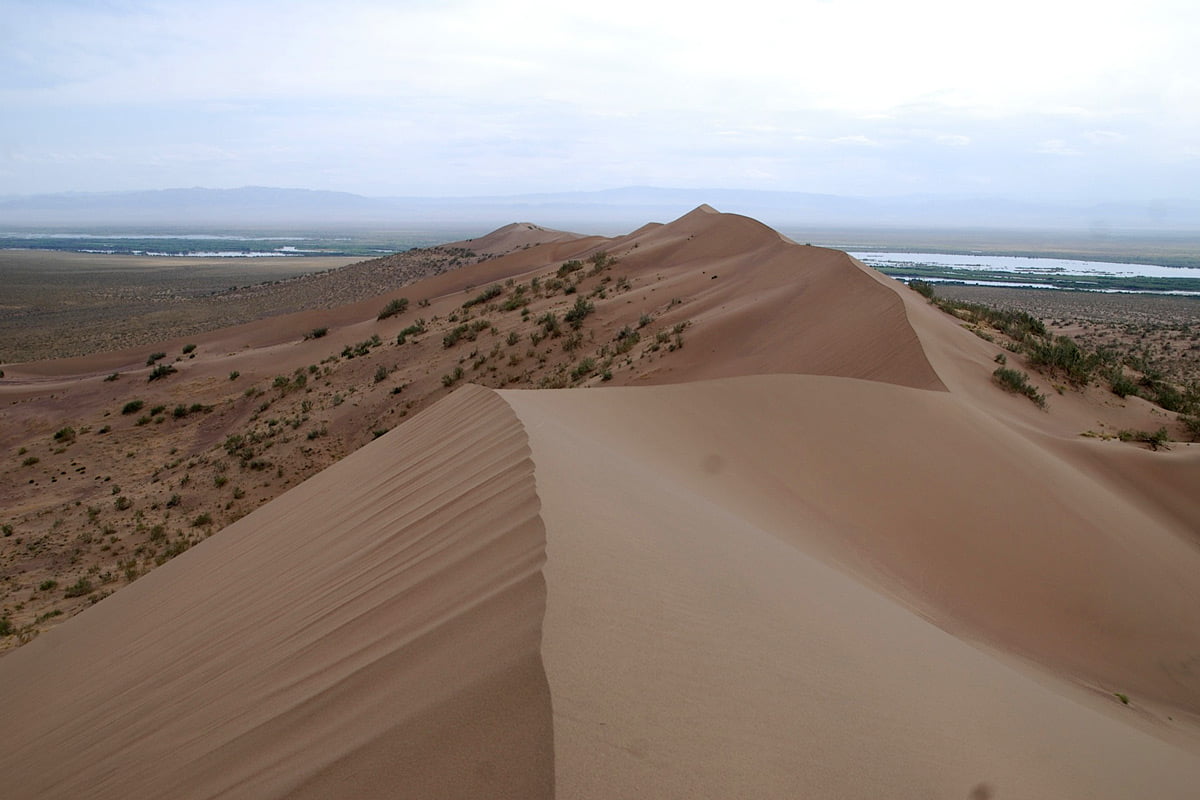Almaty - Altyn Emel National Park
 In the heart of Central Asia, in the valley of the river Ili, in the Almaty region, lies the Altyn Emel State National Park. The park was established in 1996 to preserve the unique natural complex of the area.
In the heart of Central Asia, in the valley of the river Ili, in the Almaty region, lies the Altyn Emel State National Park. The park was established in 1996 to preserve the unique natural complex of the area.
The huge Singing Dune, located in the sands of Altyn Emel, is very popular. The length of the dune is two to three kilometres and its height is about 120 metres. The dune is known for its melodic sound in dry weather, which is why it is also called the Singing Dune. Its song can be heard several kilometres away from here. The sound is created when the smallest grains of sand rub against each other: A blowing wind produces an easy-to-detect squeak, while strong gusts produce a more intense and expressive sound similar to that of an organ. But you can also listen to the Barkhan’s melodies in calm weather. When you step on the surface of a dune, the grains of sand rub against each other, producing an unusual sound. The Barkhan does not migrate despite the wobbly sand, but has been on the territory of “Altyn Emel” for several thousand years. Local legends say that the great Genghis Khan and his loyal warriors are buried under the sands of the Barkhan and the sands sing when the Khan’s soul, “exhausted by mental anguish, tells his descendants of his exploits”.
The five royal burial mounds, called Besshatyr, which translates from Kazakh as “five tents”, are the most famous sights of Altyn Emel. They are earthen mounds that resemble ordinary hills and are more than 20 metres high. Scientists have found that they contain the remains of Sak chiefs who lived around the VII-III century BC. Along the burial mounds are 45 massive stone blocks with carved images of animals. Tourists who see these unusual rows of stones for the first time compare them with the famous English Stonehenge.
There is also a famous monument with ancient rock carvings of Tamgaly Tash. They were carved more than two thousand years ago, around the XVI-XIV centuries BC. They are mainly drawings of mysterious deities and Buddhist inscriptions. The petroglyphs depicting the Buddha Shakyamuni, the Buddha of Infinite Light Amitabha and the Bodhisattva of Infinite Compassion Avalokiteshvara are widely known among connoisseurs of Indian culture. Many archaeologists from different parts of the world come here to see these mysterious drawings whose enigma is yet to be fully solved. Renato Sala, an Italian archaeologist who was here, said Tamgaly Tas was a very rare monument. He suspected that it was a sacred temple for Buddhists, used for prayers and meditation. The ancient Turkish runic inscriptions from the VIII to IX centuries have been preserved at Tamgaly Tas. They may have been left by the Kipchaks.
The magnificent mountains of Katutau and Aktau with their unusual contours are also an attraction of “Altyn Emel”. On the former were small volcanoes that gave Katutau its unique appearance. The mountain represents flaming lava erupting from a volcano and immediately cooling down again. Thousands of years later, the extraordinary shapes have been miraculously preserved. There are all sorts of shapes and sizes of holes, depressions, crevices and twists, reminiscent of a shelf, a bowl or a king’s chair. There is even a Martian stone in which a cradle is formed into which a human being can easily fit. In general, with a wild imagination, you will always know what is what.
The red, green, pink and even bluish marine deposits that cover the intricate stony slopes of the Aktau Mountains are amazing. The fact is that Aktau was formed on the site of the former sea, which left its mark on the surface of the mountains. Bones of dinosaurs were once found in the mountains of Aktau, and the remains of later species can still be found here.
Altyn Emel is also rich in unusual plant and animal species. The park is home to 634 plant species, 41 of which are rare and 27 endemic. A huge elm tree grows here that is over 700 years old. Near this elm is a stream that quenched the thirst of Genghis Khan’s companions. It takes eight people to reach this elm, it is so big. There is also a tree with incredibly hard bark that people used to carve bullets from. It has the nickname “stone tree”.
Of the animals living in the park, 56 species are listed in the Red Book of Kazakhstan. These include the snow leopard, the Manul wildcat, the otter, the Central Asian river otter and the stone marten. The graceful Turkmen culans, which were completely wiped out in the 1970s, live here. Eight years later, 23 kulans were brought here from Barsa Kelmes Island. Today there are about 700 Turkmen kulans in Altyn Emel.
40 bird species inhabiting the reserve have been included in the Red Book of Kazakhstan. More than half of the reptile species found in the Almaty region and Kazakhstan live in the reservoirs and swamps of Altyn Emel National Park. The Ili River and Kapchagai Reservoir are rich in fish such as carp, white amur, catfish, bream, zander and asp. Ili marinka, Balkhash perch and spear are listed in the Red Book of Kazakhstan. The sandy banks of the Ili are a great place to rest, sunbathe and swim in the warm water. Here you can see a hundred-metre-high cliff of red stone overlooking the river.
On the way from one sight to the next, you can try Kazakhstan’s national drinks, shubat and kumys, which are excellent thirst quenchers. You can also stop and ride a horse or camel.
